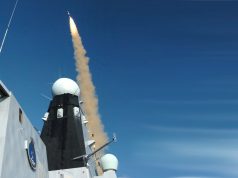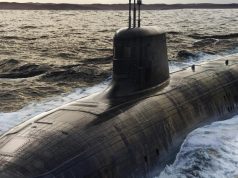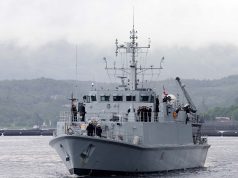The Royal Navy is trialing gliders that can aid Royal Navy anti-submarine warfare operations.
A Teledyne-built Slocum glider is being tested to the limit as it hoovers up information about the seas west of Scotland during a five-month deployment.
The unmanned Slocum – using its array of sensors – is capable of sending near real-time information on temperature, depth, salinity (salt content), currents, oxygen levels, turbulence and more.
These parameters can impact the efficiency of the sonar and sensors used by the Type 23 frigates and Merlin and Wildcat helicopters – as well as the Royal Air Force’s P-8 Poseidon – during submarine hunting operations.
Currently, data collection takes months, but these gliders can not only provide insight, they can also relay information in a matter of hours.
The intention is for the navy to eventually deploy gliders continually to high-threat areas to give a clear and constant picture of the underwater battlespace, meaning operational decisions will be based on the very latest information.
“Ocean environments are changing – what we knew 20 or 30 years ago doesn’t apply now in many areas, particularly the North Atlantic which is our backyard for submarine operations and probably one of the most complicated and challenging bodies of ocean,” said Captain Pat Mowatt RN.
“Salinity, sound velocity and temperature have all changed. We need to know these accurately as we strive to understand more and more about the undersea environment (battlespace) and how this effects the performance of ship and submarine sensors so we can achieve an operational advantage.”
Project Hecla
Right now, the Royal Navy continues to trial these gliders as part of Project Hecla. One of them is currently off the North West coast of the Outer Hebrides.
The Slocum was due to stay out for four weeks but has been extended to up to five months, giving the project the opportunity to test the glider to its limits on a long duration mission for the first time.
The data is being integrated into ocean forecast models by the Met Office and is available for use by the Navy at the Joint Operational Meteorology and Oceanography Centre at Northwood.
These trials are supported by the National Oceanographic Centre, British Oceanographic Data Centre and the Scottish Association of Marine Science.
During these latest tests, the project has been able to look at reducing power consumption of on-board sensors to extend battery life and resolve teething issues of getting data from the shore-side receivers to the Met Office.
Project Hecla was established to optimise the Navy’s ability to collect and exploit hydrographic and oceanographic information and they are continuing to look at other opportunities on top of the gliders.
Among those are ‘profiling floats’ (basically a cylinder packed full of sensors) that can operate for three to four years once they are in the water, sending subsurface measurements to shore.
The project will also trial how autonomous vehicles can aid data collection and exploitation missions alongside NavyX, who are responsible for developing and testing new technology for potential use on the frontlines.
Project Hecla is also involved in maintaining safety of navigation for all ships using autonomous vehicles.



























